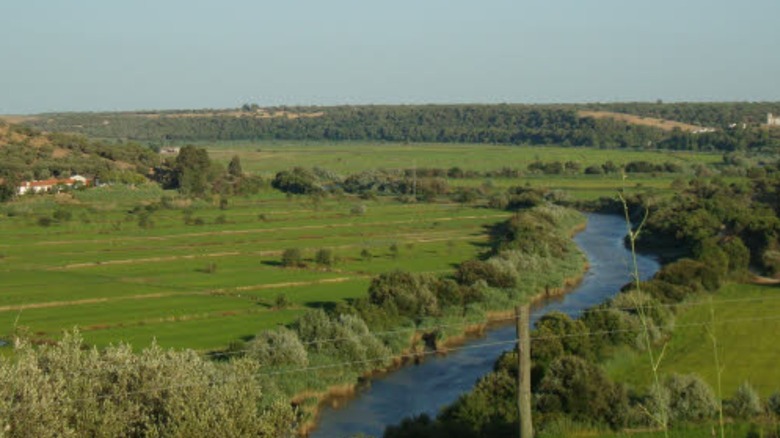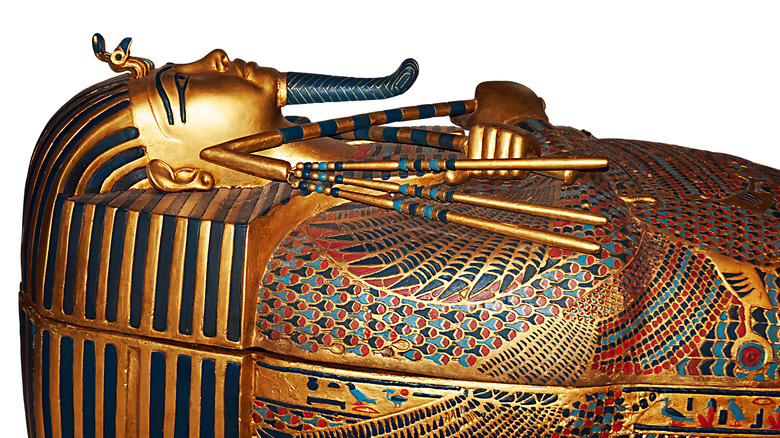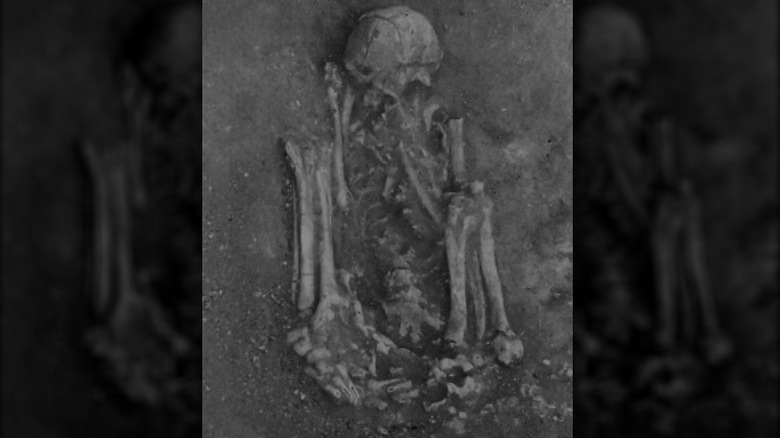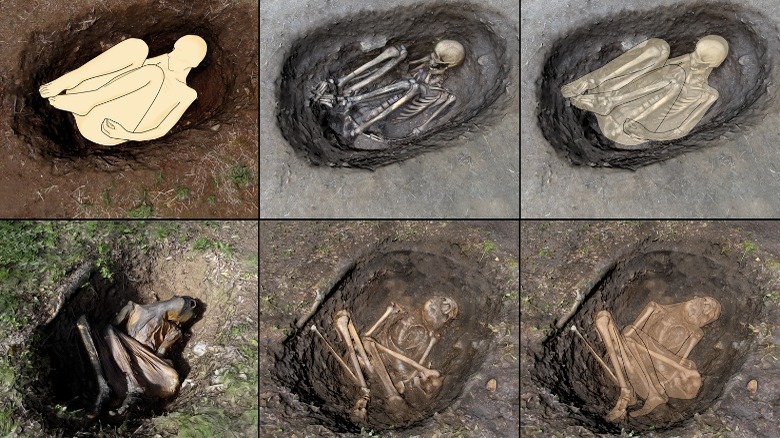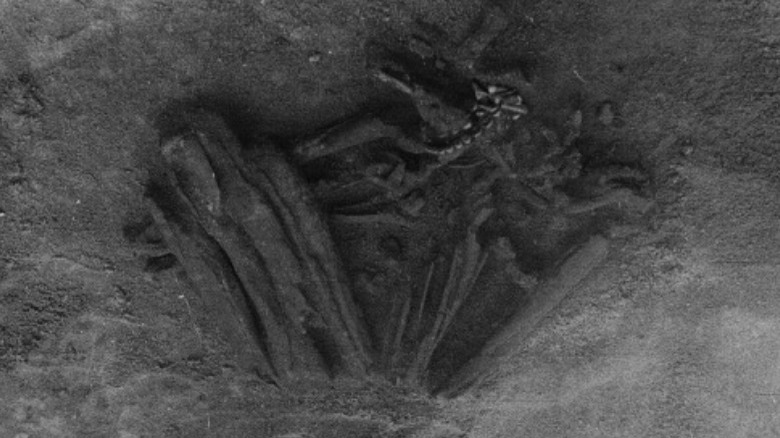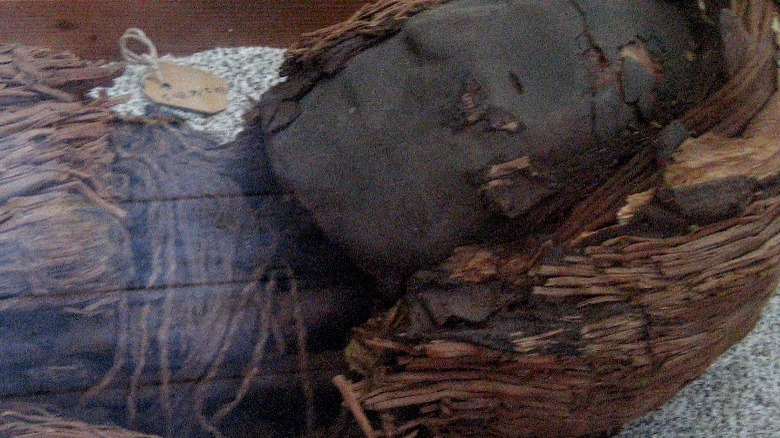This Is The Oldest Known Mummy In The World
Where was the first mummy in the world buried? Not, as it turns out, in an Egyptian pyramid or a Chilean desert (not so far, anyway), but in a valley in Portugal. At least that's a possibility floated by a study published in the European Journal of Archaeology in March 2022. Researchers discovered previously undeveloped photographs from an early 1960s excavation of burial grounds in Portugal's Sado Valley. The bodies dated from the Mesolithic era, around 8,000 years ago. By examining the photographs, the researchers determined that at least one of the bodies may have been mummified.
"This discovery shows that mummification of dead bodies occurred in Europe already during the Stone Age," Liv Nilsson Stutz, one of the study's main authors and a professor of archaeology at Linnaeus University, said in a press release. Before, the oldest known mummies in Europe dated from the Bronze Age, several thousands of years later. But the discovery isn't just a big deal for Europe. "This could even be the oldest known mummy in the world," Nilsson Stutz said.
What is a mummy?
What exactly is a mummy? "A mummy is a dried-out cadaver in which the natural decomposition processes have stopped as the body is so dry that the bacterial growth stops," Liv Nilsson Stutz said in the Linnaeus University press release. Mummification can occur naturally if a body is buried in a dry place like a desert. It is also something humans can do on purpose by preparing the body in certain ways. Ancient Egypt, for example, is famous for its elaborate sarcophagi and detailed mummification process that took several days. That process included removing the brain through the nose with special instruments, as Smithsonian explains. But the process can actually be very simple.
Nilsson Stutz said in the press release that one method was just to raise the body above the ground so that the liquids that were created as it decomposed drained downward. This process could be accelerated by sticking a cane into a body opening or lighting a fire nearby. "What is important to understand is that you do not need a lot of technology to turn a dead body into a mummy," Nilsson Stutz said. However, one challenge for archaeologists is that mummification can be hard to identify in prehistoric burial sites because the body's soft tissue is not often preserved. This is especially a problem in temperate, moist climates like Europe's.
Photographic evidence
There was no soft tissue left on the bodies excavated from two sites in Portugal's Sado Valley, Arapouco and Poças de S. Bento, in the 1960s, the study said. Most of the material from the excavations was housed at the National Museum of Archaeology, but some photographs and other documents were missing. Then, study co-author João Luís Cardoso discovered three rolls of undeveloped film in the personal archive of the late archaeologist Manuel Farinha dos Santos. When the researchers developed the film, they noticed something unusual about one of the bodies. "We could see that the skeleton was not positioned in a natural way in the grave," Liv Nilsson Stutz said in the Linnaeus University press release.
The bones in the photograph were hyperflexed — the body's limbs had been stretched in a way they would not normally rest, Live Science explained. This was evidence that the limbs had been tied in place and the bindings had since disintegrated. Further, there was evidence that the body had not decomposed in the usual way. First, the bones, in particular the feet, were still articulated, or connected and in their proper position. Usually the foot bones collapse as a body decomposes. Second, when a body decomposes, it normally shrinks in the grave and soil falls in to fill the space. There was no evidence of this in the photograph. "This looks like what we know about mummification," Nilsson Stutz said in the press release.
Archaeothanatology
In analyzing the photograph, the researchers were using a method called archaeothanatology — studying human remains based on knowledge about how the human body decomposes and focusing on the placement of bones in a grave, as an Uppsala University press release explained. In this case, the researchers were able to determine that the body was likely mummified based on the hyperflexion of the bones and the lack of evidence of decomposition. "Ideally, archaeothanatology relies on detailed field observations of the precise position, orientation, and dip of each bone in the field, documented in three-dimensional coordinates, but this was obviously not available here," the researchers wrote in the European Journal of Archaeology.
To fill in these gaps, the researchers turned to experiments that one of the study authors, Harley Mickleburgh, had performed at the Forensic Anthropology Research Facility at Texas State University between 2015 and 2021. Mickleburgh had buried two bodies, one that she mummified and one that she did not, according to the Linnaeus University press release. After a few years, she exhumed them and compared their appearance in the grave. "The Stone Age grave that we have studied in Portugal was similar to the dead body in the experiment that was mummified before burial," Liv Nilsson Stutz said in the press release.
A second mummy?
One of the other recovered photographs from Sado Valley also showed some signs of mummification, according to the European Journal of Archeology. The corpse also showed signs of hyperflexion. "The position of the body in the grave appears extremely 'flattened,' and very little sediment is present between overlying bones," the study authors wrote. As in the first photograph, the body's lower limbs were bunched together and the body did not appear to have shifted in the grave over time, suggesting it might have been prepared for burial in the same way.
If the authors of the study are correct — one or both of the bodies were mummified — it tells us a lot about the Mesolithic Portuguese. Namely, it shows that they cared about preserving the body after death and that the Sado Valley burial sites were especially important. "These practices would ... underscore the significance of the burial places and the importance of bringing the dead to these locations in a manner that contained and protected the body, following principles that were culturally regulated," the study authors wrote.
Altering the timeline
Before the discovery of the Sado Valley photographs, the oldest known mummies dated from around 7,000 years ago, created by the Chinchorro hunter-gatherer community that lived along the coast of Northern Chile near the Atacama Desert, according to the Uppsala University press release. The earliest Chinchorro mummies were naturally preserved by the dry climate, according to the Guinness Book of World Records. The earliest Egyptian mummy, meanwhile, has been dated to around 4500 B.C. However, most known mummies date from a few hundred to 4,000 years ago, Uppsala University said.
The new discovery opens up the possibility that there might be even older mummies waiting to be unearthed. Archaeologist Michael Parker Pearson of University College London told Live Science that there was some evidence for mummification in remains found at El Wad and Ain Mallaha in Israel, dating from 10,000 years ago, and at Kosteni in Belarus, from around 30,000 years ago. "These sites are just crying out for the type of analysis carried out in this new study," he said.
